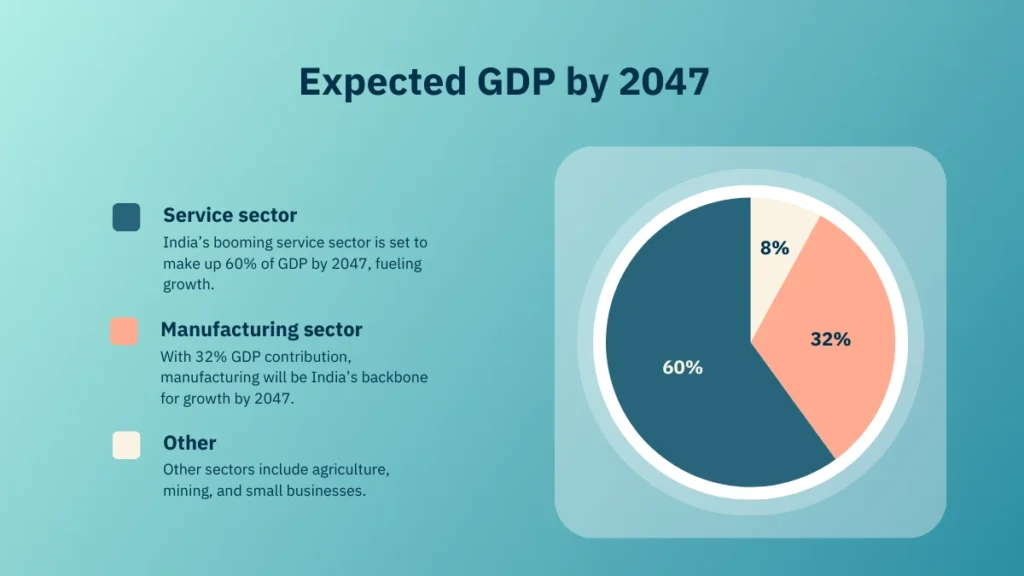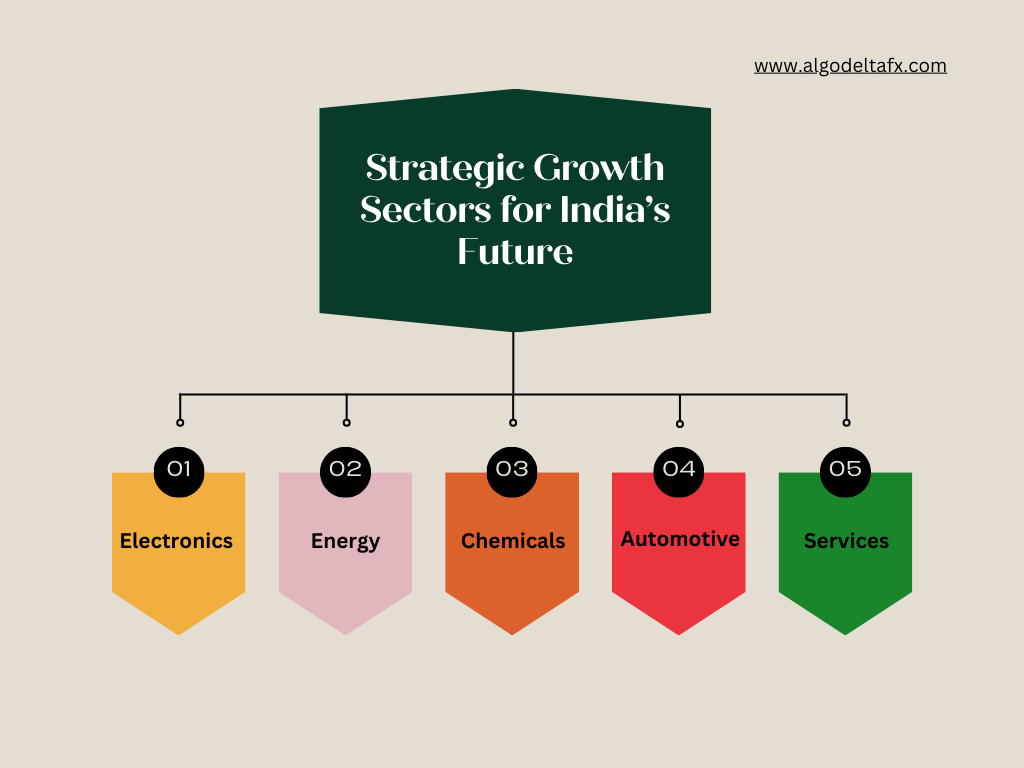
India is on track to become a high-income country by 2047, with its GDP projected to reach between $23 trillion and $35 trillion. The country’s rapid transformation is largely driven by the services sector, which is expected to contribute 60% to the GDP, while the manufacturing sector will account for 32%. This shift underscores India’s potential to emerge as a global economic powerhouse.

The Role of Services and Manufacturing in Economic Expansion ⚙️🏢
By 2047, the services sector will be the backbone of India’s economy, driving employment and innovation. The manufacturing sector, too, will play a crucial role, benefiting from advances in AI, automation, and backward integration. These developments are set to boost India’s competitiveness, increase export shares, and enhance overall productivity.
Workforce Growth and Skill Development: A Key Opportunity 💼
“With nearly 200 million individuals expected to enter the workforce in the coming decades, India has a unique opportunity to drive high-value job creation and unlock significant economic potential.”

A projected workforce shortfall of 50 million by 2030 highlights the urgent need for improved STEM (science, technology, engineering, and mathematics) education and targeted skill development programs. Addressing these gaps is essential for sustaining long-term economic growth.
The Impact of Technological Advancements on India’s Economy 🤖
Innovations in AI-driven chip design, touchless manufacturing, and deep integration into component production will significantly enhance cost efficiency and innovation. By 2047, these advancements could push the manufacturing sector’s export share from 24% to around 45%-50% and increase its GDP contribution from 3% to 8%-10%.
Renewable Energy and Sustainable Growth 🌿

India is making significant strides in renewable energy, aiming to boost its share in total energy production from 24% in 2023 to around 70% by 2047. This shift aligns with global sustainability trends and positions India as a leader in clean energy innovation.
Want to know more about renewable energy stocks? Read here.
The Auto-Component Industry: A Rising Export Powerhouse 🚗
“Likewise, the auto-component export sector is projected to reach $200-250 billion (2047) driven by share capture in ICE market and longer-term shift to EVs.”
This evolution will solidify India’s position in the global automotive industry.
Strategic Growth Sectors for India’s Future 📈
India’s economic rise will be driven by five key sectors:
- Electronics: Expanding semiconductor and hardware manufacturing.
- Energy: Strengthening renewable energy capacity.
- Chemicals: Enhancing production and exports.

- Automotive: Accelerating EV adoption and component manufacturing.
- Services: Digital transformation and IT-driven growth.
These sectors align with global trends and India’s strategic goals, making them essential pillars of future economic expansion. Rising incomes, a skilled workforce, and continued infrastructure improvements will further fuel this growth.
Addressing Key Challenges 🛠️
While India’s economic outlook is promising, certain challenges need to be addressed:
- Workforce Shortages: “A projected workforce shortfall of approximately 50 million individuals by 2030 highlights the need for enhanced STEM education and focused skill development programs across various sectors.”
- Dependence on Imports: Increasing backward integration and local manufacturing can reduce reliance on imported components.
- Public-Private Collaboration: “Public-private collaboration in AI, green energy, and other critical sectors and enhancing R&D investment as a percentage of GDP could accelerate domestic innovation and reduce dependence on global supply chains.”
Strengthening Infrastructure and Innovation 🏛️
India’s economic progress depends on:
- Expanding Digital & Transport Infrastructure: Enhanced connectivity and smart city initiatives will drive efficiency and growth.
- Bridging Skill Gaps: Investing in education, upskilling, and reskilling programs will prepare the workforce for the future.
- Boosting R&D Investment: Encouraging innovation through increased research funding and global partnerships.

A Tech-Driven Future for India 💻
“India’s economic growth depends on strengthening infrastructure, bridging skill gaps, and fostering innovation through technology and global partnerships. By investing in digital and transport infrastructure, enhancing domestic manufacturing, and driving collaborative R&D, we can position India as a leader in future technologies and global trade. A multi-pronged, tech-driven approach will be key to unlocking inclusive and sustainable growth.” – Nasscom Sr. Vice President Sangeeta Gupta
Conclusion: India’s Bright Economic Future 🌟
With a strategic focus on technology, infrastructure, and workforce development, India is well-positioned to achieve its high-income status by 2047. By leveraging its strengths in the services and manufacturing sectors, adopting cutting-edge technologies, and prioritizing sustainable development, the country can create a robust, resilient economy that benefits all.
For more insights on market trends and finance, follow our blogs!
Disclaimer: This article is for informational purposes only and not financial advice. Always do your own research before investing.
source : business-standard



